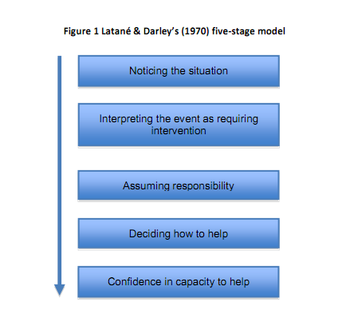Theories associated with bystander intervention
Diffusion of responsibility:
“The concept of ‘diffusion of responsibility’ has been used…to explain why it is that individuals might be less likely to offer assistance to intervene to prevent a crime in a group setting. For example, Darely and Latane’s original (1968) study theorized that in group settings, the responsibility for intervening was diffused among the bystanders, such that individuals were less likely to feel responsible for taking action, and were more likely to think that somebody else may intervene or had already called for help.”
According to Darley and Latane (1970), bystanders go through the following five stages before determining what course of action they will take (to intervene or not):
Theory of Planned Behavior:
“The Theory of Planned Behavior (TPB)… seeks to take into account a range of factors determining behavior, including: an individual’s attitudes and beliefs, social norms, an individuals’s subjective perception of social norms, perceived behavioral control (which refers to an individual’s perception of the potential constraints on their action) and, finally, individual intention to act.”
– Definitions from the Victorian Health Promotion Foundation report “Review of bystander approaches in support of preventing violence against women”
